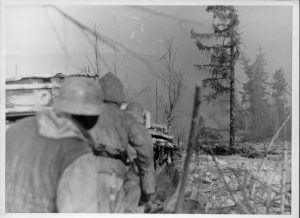Hi Gents,
Took me long this time to write another post but I was handicapped and couldn`t use my right hand.
What happened…. something bit me in my hand, some sort of Insect but we did not find out what ist was. Happened on a Monday morning, on Tuesday morning I was in the hospital with a hand like “HellBoy” and, as the doctors told me “close to Heavens door”. Anyway, they cut down my wedding ring and put me 3 days on hard medication to survive the blood poisoning…..Took me another week to use my hand again and now I can write slowly.
I Hope the responsible „whatever“ died after it bit me…..
Back to our hobby !
I scanned the net and checked different platforms for news on medals and badges. Found several interesting post on GCA, WAF and MFF. One posting let me think…..and finally I found out that I had never thought about it. It was all about cased wounded badges of World War II.
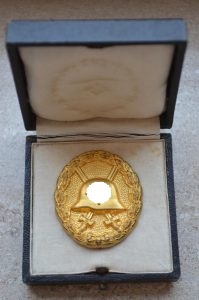
Easy area you think, you have already a black one, a silver and gold wounded badge and maybe this beautiful version…..uhhhh Legion Condor wounded badge…….but let`s start in the beginning. We have to get the terminology right. A lot of you talk about the legion condor wounded badge and the wounded badge of World War II. That is not the right way to put it down. We have to say it that way: Wounded Badge 1. pattern and the Wounded Badge 2. pattern.
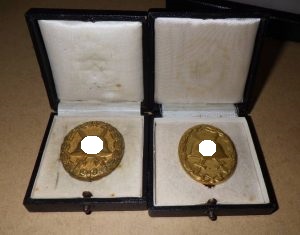
The wound badge was originally established on March 3rd, 1918 by King Wilhelm II to recognize the sacrifice of those wounded during World War I. The badge was instituted in three classes with the class bestowed reflecting the number or severity of the wounds received. On May 22nd, 1939 Hitler re-instituted award of the black and silver WWI pattern wound badges, with the addition of the swastika, for bestowal to German volunteers, (Legion Condor), who had participated in the Spanish Civil war from 1936 – 1939. Of Note: Only one hundred eighty-two black and one silver badge were awarded to Condor Legion veterans.
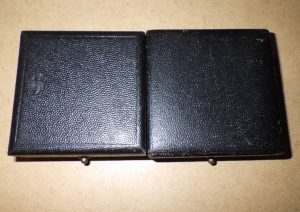
With the outbreak of WWII, on September 1st, 1939, Hitler once again re-instituted another slightly modified version of the wound badge by altering the World War I pattern helmet on the badge to the newly designed M35 style helmet. The badge was awarded to both military and uniformed non-military personnel and later, (March 1943), to civilian personnel who received wounds as a result of enemy actions. The black wound badge was the lowest of the three classes and was awarded for one or two wounds.
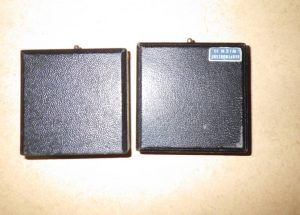
The silver wound badge was awarded for three or four wounds, or if the wound was very severe, ie: loss of limb, blindness, etc..
The gold wound badge was the highest of the three classes and was awarded for five or more wounds, or if the individual was totally disabled. It was also awarded posthumously if the individual was killed in battle.
Interesting fact is hat the wounded badge 1st pattern was given out until 1940 because there were not enough second pattern finally made by the companies to give them to all soldiers who earned the badge.
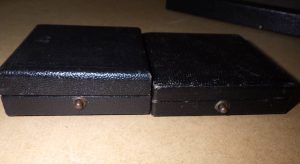
So now let`s go back to the cased badges. If you examine a wounded badge 2nd pattern in gold it normally will come in a black case with white inlet.
If you were lucky enough to get a golden wounded badge 1. pattern which is also “hohl verbödet” (which means a hollow badge where the maker put a piece of metal on the back side to let it look like a flat back badge)and it is cased, this little friend will come in a black case with white inlet…..but be careful……it is like in your bedroom….the size matters.
Pictures collection Jelle



The cases for 1. pattern and 2. pattern are not the same size and I will show that with a few pictures from my collector Friend Heinrich.
As you can see the 1st pattern case is smaller, has an imprint on the top of the case and is higher than the standard black WB case. Everything is only in millimeter size but you can see it.
Pictures collection Heinrich








Shortly after start searching about WB cases I found an interesting post in the WAF where some other collectors posted their cases of.
Pictures collection Gary





Here was a statement that the wounded badges 1st pattern gold case was also used for the Wounded Badge July 20, 1944. The same maker and the same size was the information. I hope we can proof that one day or some of the collector`s who owns one will provide me with pictures and sizes.
Thanks to Henrich, Gary, Jelle and Hans for helping me out with basic information and good pictures!
That’s it so far, hope you will get back after all the DSGVO (EU General Data Protection Regulation) storm in the internet.
Thanks for reading, please help the blog to get more readers and more writers……Let the other collectors know what you can find here.
Take care
Best
Sascha
